2011 BMW 323I tire size
[x] Cancel search: tire sizePage 217 of 286
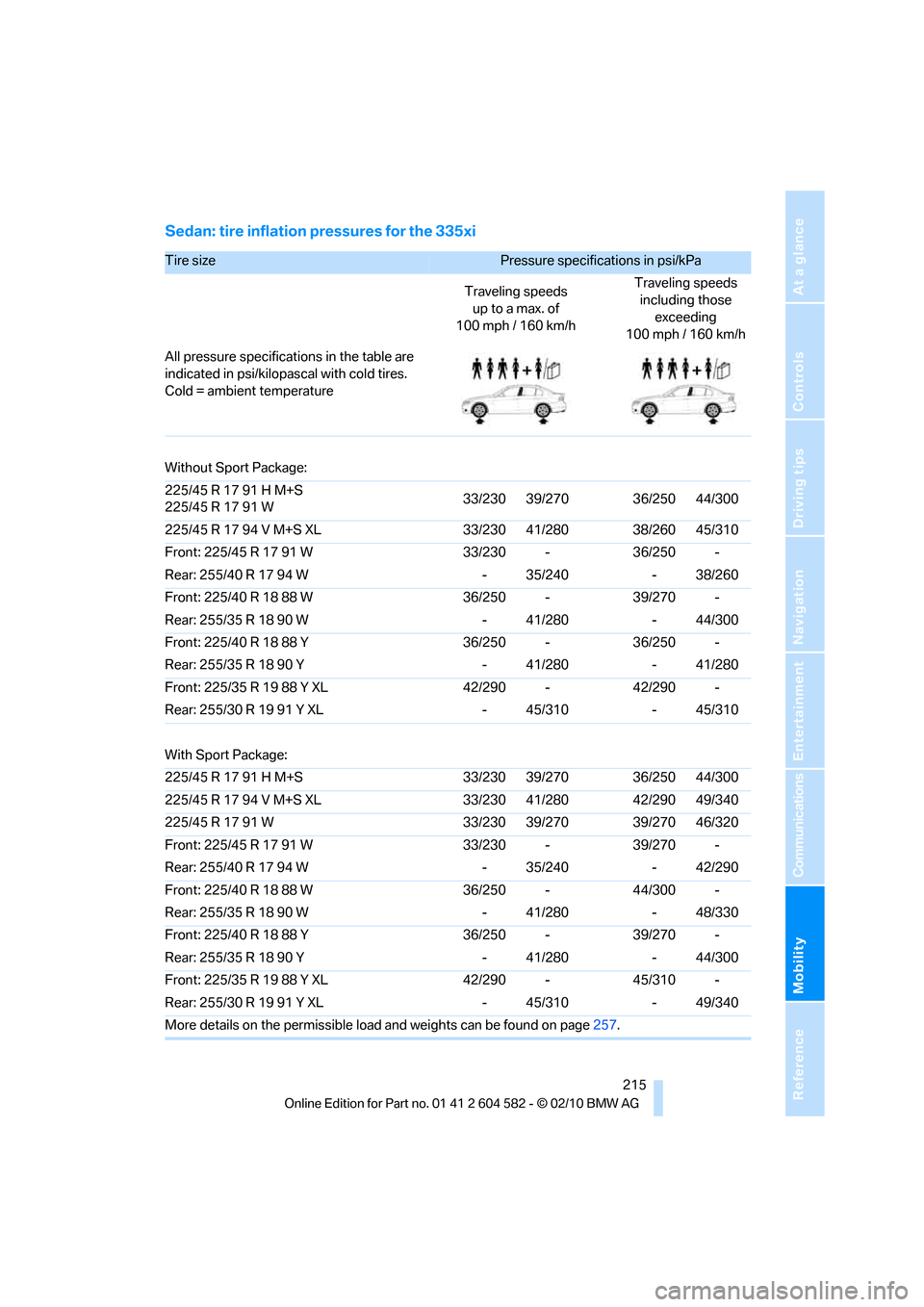
Mobility
215Reference
At a glance
Controls
Driving tips
Communications
Navigation
Entertainment
Sedan: tire inflation pressures for the 335xi
Tire size Pressure specifications in psi/kPa
Traveling speeds
up to a max. of
100 mph / 160 km/hTraveling speeds
including those
exceeding
100 mph / 160 km/h
All pressure specifications in the table are
indicated in psi/kilopascal with cold tires.
Cold = ambient temperature
Without Sport Package:
225/45 R 17 91 H M+S
225/45 R 17 91 W33/230 39/270 36/250 44/300
225/45 R 17 94 V M+S XL 33/230 41/280 38/260 45/310
Front: 225/45 R 17 91 W 33/230 - 36/250 -
Rear: 255/40 R 17 94 W - 35/240 - 38/260
Front: 225/40 R 18 88 W 36/250 - 39/270 -
Rear: 255/35 R 18 90 W - 41/280 - 44/300
Front: 225/40 R 18 88 Y 36/250 - 36/250 -
Rear: 255/35 R 18 90 Y - 41/280 - 41/280
Front: 225/35 R 19 88 Y XL 42/290 - 42/290 -
Rear: 255/30 R 19 91 Y XL - 45/310 - 45/310
With Sport Package:
225/45 R 17 91 H M+S 33/230 39/270 36/250 44/300
225/45 R 17 94 V M+S XL 33/230 41/280 42/290 49/340
225/45 R 17 91 W 33/230 39/270 39/270 46/320
Front: 225/45 R 17 91 W 33/230 - 39/270 -
Rear: 255/40 R 17 94 W - 35/240 - 42/290
Front: 225/40 R 18 88 W 36/250 - 44/300 -
Rear: 255/35 R 18 90 W - 41/280 - 48/330
Front: 225/40 R 18 88 Y 36/250 - 39/270 -
Rear: 255/35 R 18 90 Y - 41/280 - 44/300
Front: 225/35 R 19 88 Y XL 42/290 - 45/310 -
Rear: 255/30 R 19 91 Y XL - 45/310 - 49/340
More details on the permissible load and weights can be found on page257.
Page 218 of 286

Wheels and tires
216
Sedan: tire inflation pressures for the 335d
Tire size Pressure specifications in psi/kPa
Traveling speeds
up to a max. of
100 mph / 160 km/hTraveling speeds
including those
exceeding
100 mph / 160 km/h
All pressure specifications in the table are
indicated in psi/kilopascal with cold tires.
Cold = ambient temperature
Without Sport Package:
225/45 R 17 91 H M+S
225/45 R 17 91 W33/230 41/280 39/270 46/320
225/45 R 17 94 V M+S XL 35/240 42/290 39/270 46/320
Front: 225/45 R 17 91 V 33/230 - 39/270 -
Rear: 255/40 R 17 94 V - 36/250 - 41/280
Front: 225/40 R 18 88 W 35/240 - 39/270 -
Rear: 255/35 R 18 90 W - 41/280 - 45/310
Front: 225/40 R 18 88 Y 35/240 - 35/240 -
Rear: 255/35 R 18 90 Y - 41/280 - 41/280
Front: 225/35 R 19 88 Y XL 41/280 - 41/280 -
Rear: 255/30 R 19 91 Y XL - 46/320 - 46/320
With Sport Package:
225/45 R 17 91 H M+S
225/45 R 17 91 W33/230 41/280 41/280 48/330
225/45 R 17 94 V M+S XL 35/240 42/290 42/290 49/340
Front: 225/45 R 17 91 V 33/230 - 41/280 -
Rear: 255/40 R 17 94 V - 36/250 - 45/310
Front: 225/40 R 18 88 W 35/240 - 42/290 -
Rear: 255/35 R 18 90 W - 41/280 - 49/340
Front: 225/40 R 18 88 Y 35/240 - 38/260 -
Rear: 255/35 R 18 90 Y - 41/280 - 45/310
Front: 225/35 R 19 88 Y XL 41/280 - 44/300 -
Rear: 255/30 R 19 91 Y XL - 46/320 - 49/340
More details on the permissible load and weights can be found on page257.
Page 219 of 286
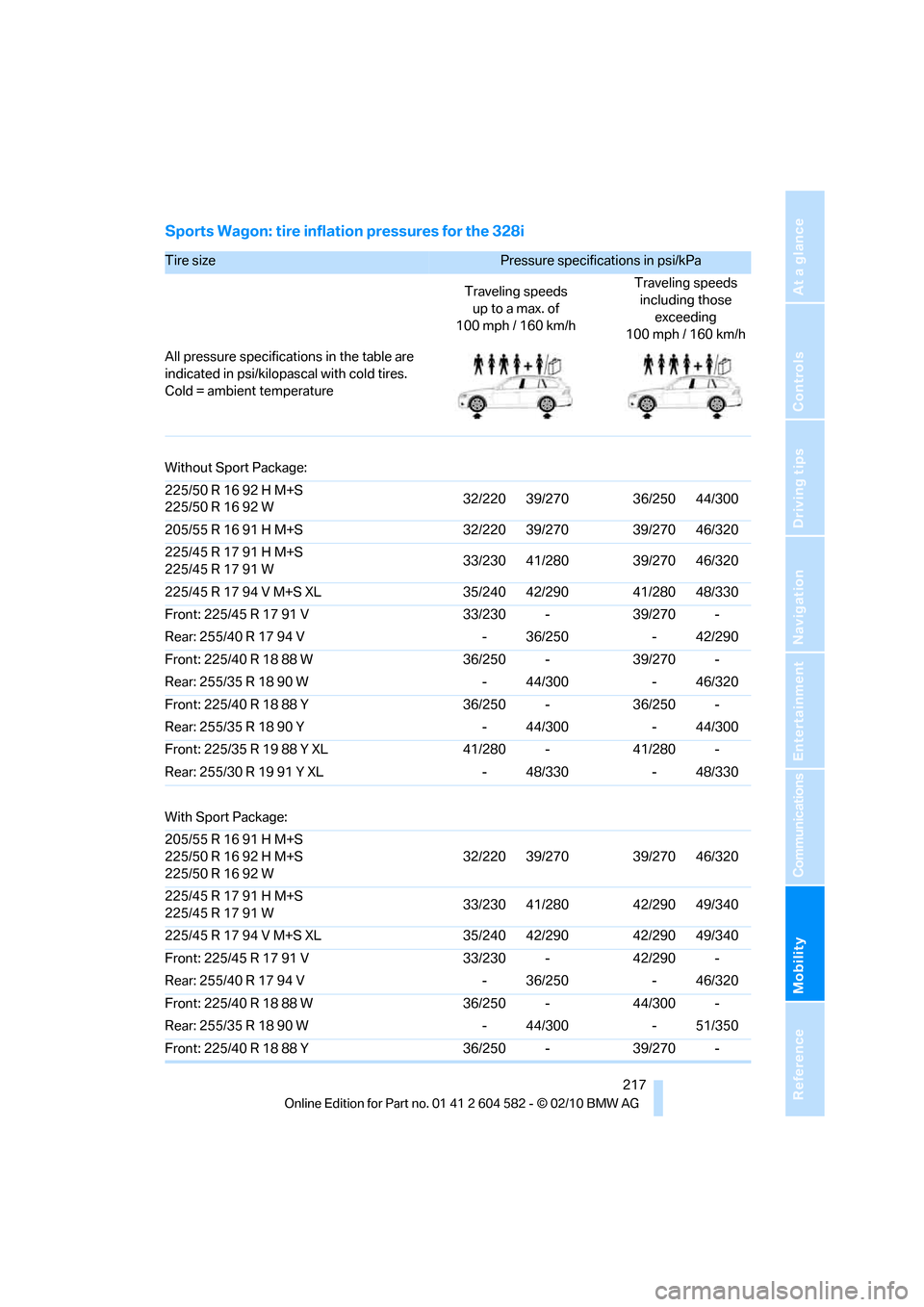
Mobility
217Reference
At a glance
Controls
Driving tips
Communications
Navigation
Entertainment
Sports Wagon: tire inflation pressures for the 328i
Tire size Pressure specifications in psi/kPa
Traveling speeds
up to a max. of
100 mph / 160 km/hTraveling speeds
including those
exceeding
100 mph / 160 km/h
All pressure specifications in the table are
indicated in psi/kilopascal with cold tires.
Cold = ambient temperature
Without Sport Package:
225/50 R 16 92 H M+S
225/50 R 16 92 W32/220 39/270 36/250 44/300
205/55 R 16 91 H M+S 32/220 39/270 39/270 46/320
225/45 R 17 91 H M+S
225/45 R 17 91 W33/230 41/280 39/270 46/320
225/45 R 17 94 V M+S XL 35/240 42/290 41/280 48/330
Front: 225/45 R 17 91 V 33/230 - 39/270 -
Rear: 255/40 R 17 94 V - 36/250 - 42/290
Front: 225/40 R 18 88 W 36/250 - 39/270 -
Rear: 255/35 R 18 90 W - 44/300 - 46/320
Front: 225/40 R 18 88 Y 36/250 - 36/250 -
Rear: 255/35 R 18 90 Y - 44/300 - 44/300
Front: 225/35 R 19 88 Y XL 41/280 - 41/280 -
Rear: 255/30 R 19 91 Y XL - 48/330 - 48/330
With Sport Package:
205/55 R 16 91 H M+S
225/50 R 16 92 H M+S
225/50 R 16 92 W32/220 39/270 39/270 46/320
225/45 R 17 91 H M+S
225/45 R 17 91 W33/230 41/280 42/290 49/340
225/45 R 17 94 V M+S XL 35/240 42/290 42/290 49/340
Front: 225/45 R 17 91 V 33/230 - 42/290 -
Rear: 255/40 R 17 94 V - 36/250 - 46/320
Front: 225/40 R 18 88 W 36/250 - 44/300 -
Rear: 255/35 R 18 90 W - 44/300 - 51/350
Front: 225/40 R 18 88 Y 36/250 - 39/270 -
Page 220 of 286
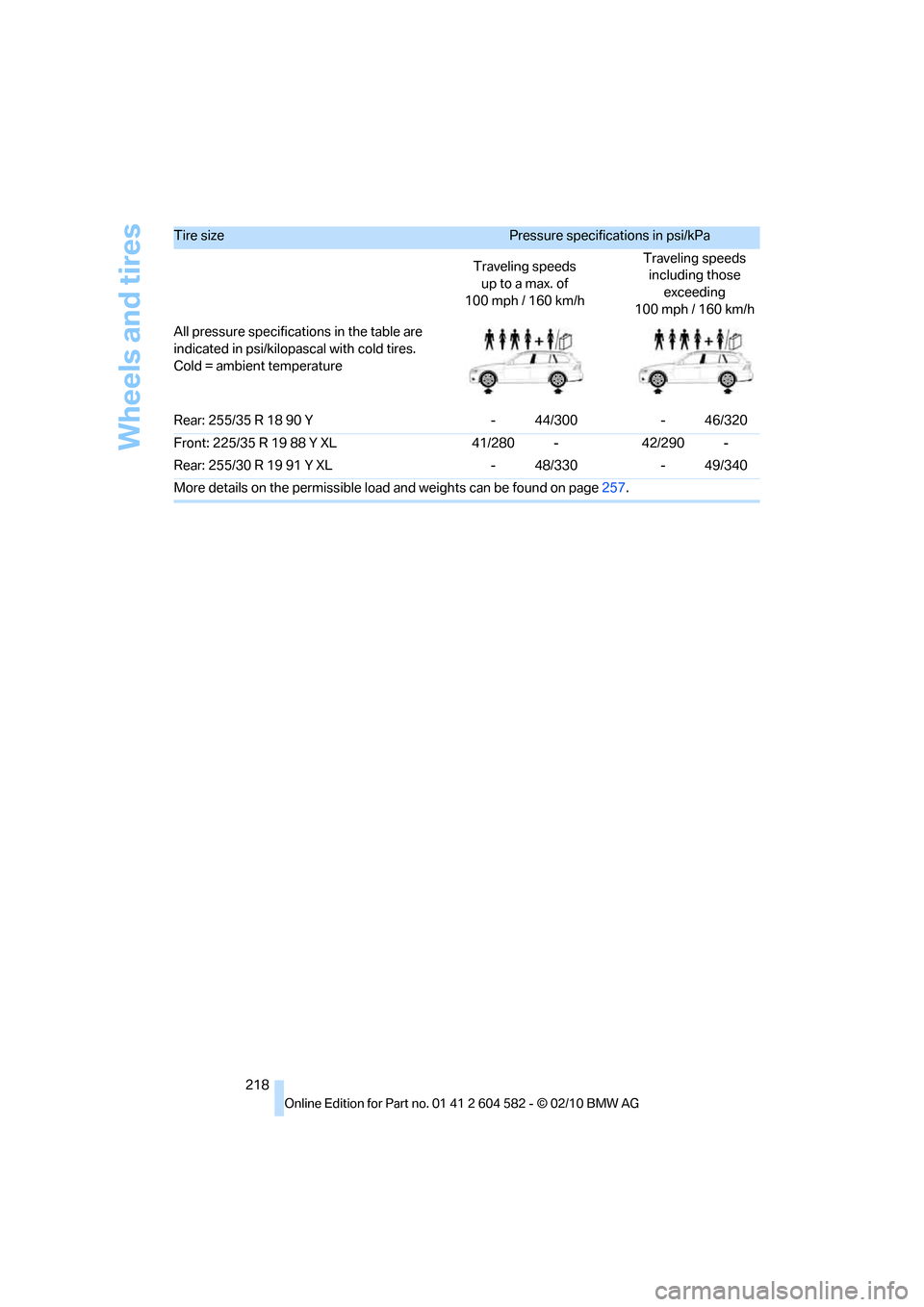
Wheels and tires
218 Rear: 255/35 R 18 90 Y - 44/300 - 46/320
Front: 225/35 R 19 88 Y XL 41/280 - 42/290 -
Rear: 255/30 R 19 91 Y XL - 48/330 - 49/340
More details on the permissible load and weights can be found on page257.
Tire size Pressure specifications in psi/kPa
Traveling speeds
up to a max. of
100 mph / 160 km/hTraveling speeds
including those
exceeding
100 mph / 160 km/h
All pressure specifications in the table are
indicated in psi/kilopascal with cold tires.
Cold = ambient temperature
Page 221 of 286
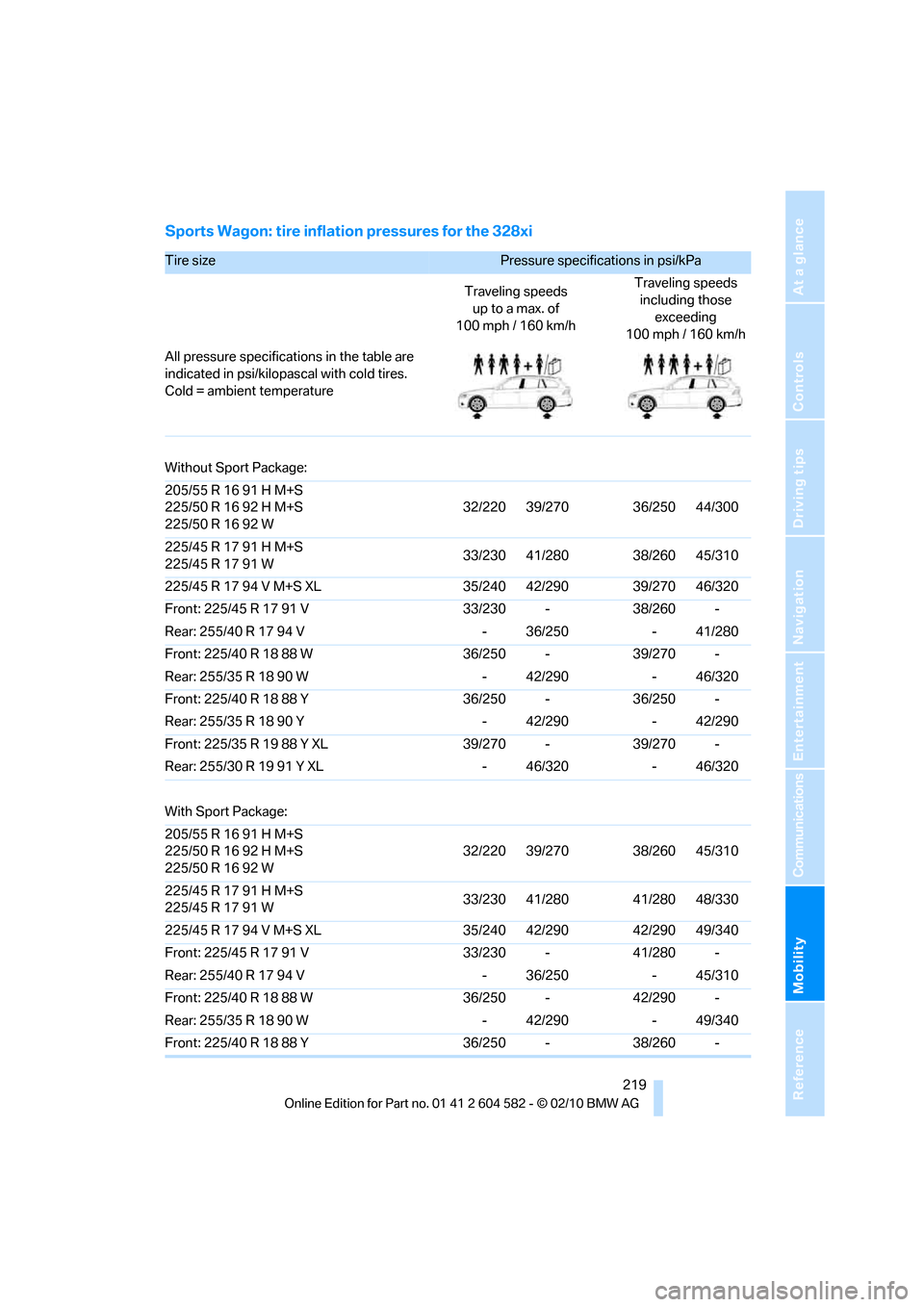
Mobility
219Reference
At a glance
Controls
Driving tips
Communications
Navigation
Entertainment
Sports Wagon: tire inflation pressures for the 328xi
Tire size Pressure specifications in psi/kPa
Traveling speeds
up to a max. of
100 mph / 160 km/hTraveling speeds
including those
exceeding
100 mph / 160 km/h
All pressure specifications in the table are
indicated in psi/kilopascal with cold tires.
Cold = ambient temperature
Without Sport Package:
205/55 R 16 91 H M+S
225/50 R 16 92 H M+S
225/50 R 16 92 W32/220 39/270 36/250 44/300
225/45 R 17 91 H M+S
225/45 R 17 91 W33/230 41/280 38/260 45/310
225/45 R 17 94 V M+S XL 35/240 42/290 39/270 46/320
Front: 225/45 R 17 91 V 33/230 - 38/260 -
Rear: 255/40 R 17 94 V - 36/250 - 41/280
Front: 225/40 R 18 88 W 36/250 - 39/270 -
Rear: 255/35 R 18 90 W - 42/290 - 46/320
Front: 225/40 R 18 88 Y 36/250 - 36/250 -
Rear: 255/35 R 18 90 Y - 42/290 - 42/290
Front: 225/35 R 19 88 Y XL 39/270 - 39/270 -
Rear: 255/30 R 19 91 Y XL - 46/320 - 46/320
With Sport Package:
205/55 R 16 91 H M+S
225/50 R 16 92 H M+S
225/50 R 16 92 W32/220 39/270 38/260 45/310
225/45 R 17 91 H M+S
225/45 R 17 91 W33/230 41/280 41/280 48/330
225/45 R 17 94 V M+S XL 35/240 42/290 42/290 49/340
Front: 225/45 R 17 91 V 33/230 - 41/280 -
Rear: 255/40 R 17 94 V - 36/250 - 45/310
Front: 225/40 R 18 88 W 36/250 - 42/290 -
Rear: 255/35 R 18 90 W - 42/290 - 49/340
Front: 225/40 R 18 88 Y 36/250 - 38/260 -
Page 222 of 286
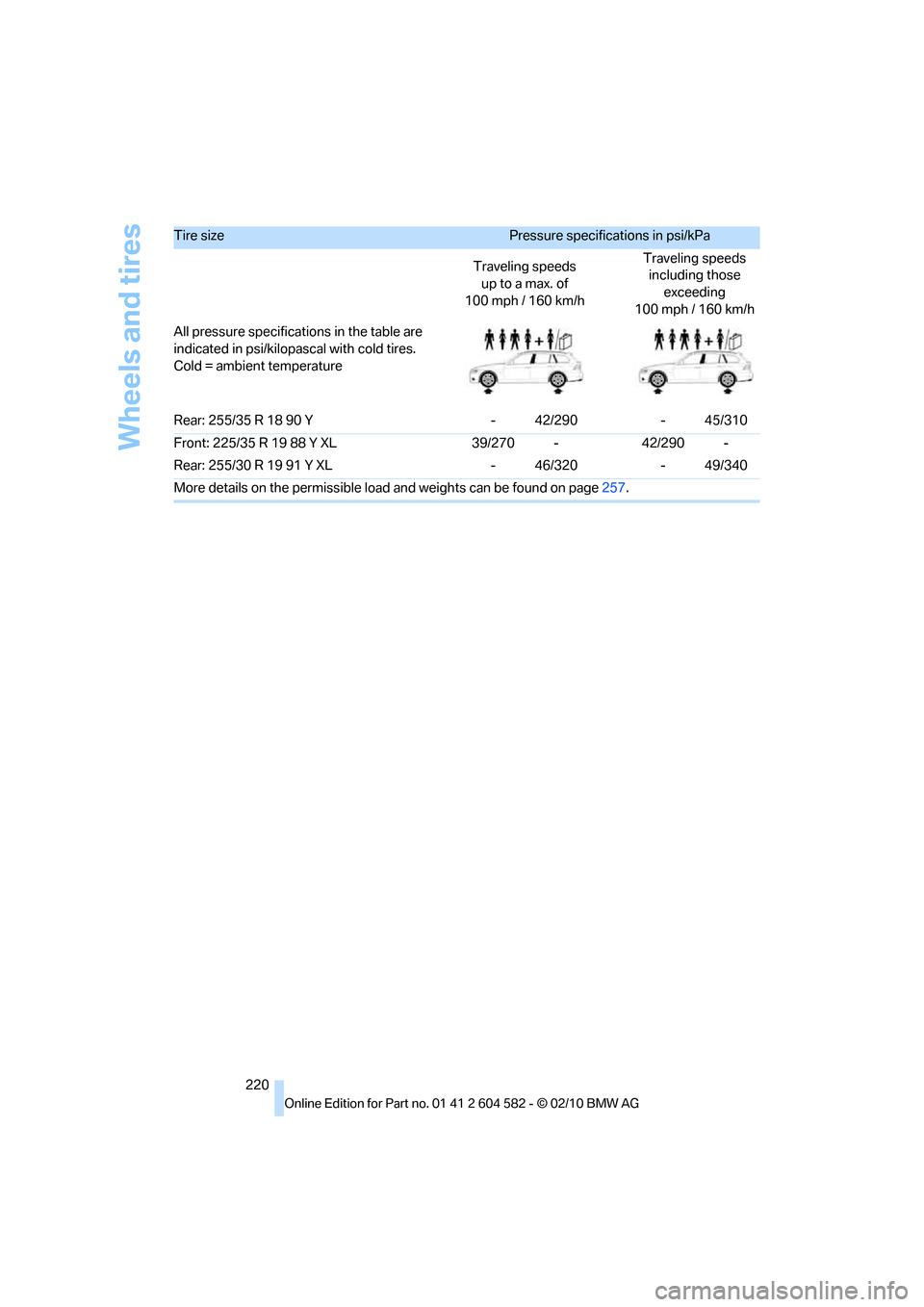
Wheels and tires
220 Rear: 255/35 R 18 90 Y - 42/290 - 45/310
Front: 225/35 R 19 88 Y XL 39/270 - 42/290 -
Rear: 255/30 R 19 91 Y XL - 46/320 - 49/340
More details on the permissible load and weights can be found on page257.
Tire size Pressure specifications in psi/kPa
Traveling speeds
up to a max. of
100 mph / 160 km/hTraveling speeds
including those
exceeding
100 mph / 160 km/h
All pressure specifications in the table are
indicated in psi/kilopascal with cold tires.
Cold = ambient temperature
Page 223 of 286

Mobility
221Reference
At a glance
Controls
Driving tips
Communications
Navigation
Entertainment
Tire identification marks
Knowledge of the labeling on the side of the tire
makes it easier to identify and choose the right
tires.
Tire size
Speed code letter
Q = up to 100 mph or 160 km/h
T = up to 118 mph or 190 km/h
H = up to 131 mph or 210 km/h
V = up to 150 mph or 240 km/h
W = up to 167 mph or 270 km/h
Y = up to 186 mph or 300 km/h
Tire Identification Number
Tires with DOT codes meet the guidelines of
the US Department of Transportation.
DOT code:
Tire age
The manufacturing date of tires is contained in
the tire coding: DOT … 1010 means that the
tire was manufactured in week 10 of 2010.
BMW recommends that you replace all tires
after 6 years at most, even if some tires may last
for 10 years.
Uniform Tire Quality Grading
Quality grades can be found where applicable
on the tire sidewall between tread shoulder and
maximum section width. For example:
Tread wear 200 Traction AA
Temperature A
DOT Quality Grades
Tread wear
Traction AA A B C
Temperature A B C
All passenger car tires must conform to
Federal Safety Requirements in addition
to these grades.<
Tread wear
The tread wear grade is a comparative rating
based on the wear rate of the tire when tested
under controlled conditions on a specified gov-
ernment test course. For example, a tire graded
150 would wear one and one-half (1γ) times as
well on the government course as a tire graded
100. The relative performance of tires depends
upon the actual conditions of their use, how-
ever, and may depart significantly from the
norm due to variations in driving habits, service
practices and differences in road characteris-
tics and climate.
Traction
The traction grades, from highest to lowest, are
AA, A, B, and C.
Those grades represent the tire's ability to stop
on wet pavement as measured under controlled
conditions on specified government test sur-
faces of asphalt and concrete. A tire marked C
may have poor traction performance.
The traction grade assigned to this tire is
based on straight-ahead braking traction
tests, and does not include acceleration, cor-
nering, hydroplaning, or peak traction charac-
teristics.<
Temperature
The temperature grades are A, the highest, B,
and C, representing the tire's resistance to the
generation of heat and its ability to dissipate
e.g.
Nominal width in mm
Aspect ratio in Ξ
Radial belt construction
Rim diameter in inches
Load rating,
not on ZR tires
Speed code letter, in
front of the R on ZR tires225/45 R1791 V
e.g.
Manufacturer's
code for tire make
Tire size and
tire design
Tire ageDOT xxxx xxx 1010
Page 225 of 286

Mobility
223Reference
At a glance
Controls
Driving tips
Communications
Navigation
Entertainment
Tire age
For various reasons, such as the development
of brittleness, BMW recommends tire replace-
ment after no more than 6 years, regardless of
the actual wear of the tires.
The manufacturing date of tires is contained in
the tire coding:
DOT ... 1010 means that the tire was manufac-
tured in week 10 of 2010.
Run-flat tires
The symbol identifying run-flat tires is a circle
with the letters RSC on the sidewall.
Run-flat tires comprise a conditionally self-sup-
porting tire and a special rim. The reinforce-
ment in the sidewalls ensures that the tire can
continue to be used subject to certain restric-
tions, even if depressurized.
For information on continuing to drive with a flat
tire, refer to Indication of a flat tire, page89.
New wheels and tires
Have new wheels and tires installed only
by your BMW center or tire shop that
works according to BMW repair procedures
with correspondingly trained personnel. If this
work is not carried out properly, there is a dan-
ger of subsequent damage and related safety
hazards. Make sure that the new wheels are bal-
anced.<
Retreaded tires
BMW recommends that you do not use
retreaded tires, since driving safety may
be impaired. The causes for this include poten-
tially different tire casing structures and often
wide variations in tire age, which can result in
a limited service life.<
Correct wheels and tires
When mounting new tires or changing over
from summer to winter tires and vice versa,
mount run-flat tires for your own safety. In the
event of a flat, no spare wheel is available. Your
BMW center will be glad to advise you.
BMW recommends that you use only
wheel and tire combinations that BMW
has tested and approved for your particular
vehicle. Variations in factors such as manufac-
turing tolerances mean that even wheels and
tires with identical official size ratings could
actually have different dimensions, which could
lead to body contact and thus to severe acci-
dents. If non-approved wheels and tires are
used, BMW cannot evaluate their suitability,
and therefore cannot guarantee their driving
safety.<
You can inquire about the right wheel/tire com-
bination at your BMW center.
The correct combination of wheels and tires is
also necessary to ensure reliable operation of
various vehicle systems such as ABS, DSC or
FTM.
To maintain good handling and vehicle
response, use only tires of a single brand and
tread configuration. After a tire has been dam-
aged, mount the previous wheel and tire combi-
nation again as soon as possible.
Wheels with Tire Pressure Monitor
TPM electronics
When mounting new tires or changing over
from summer to winter tires, or vice versa, only
use wheels with TPM electronics; otherwise,
the Tire Pressure Monitor may not be able to
detect a puncture, refer to page89. Your
BMW center will be glad to advise you.